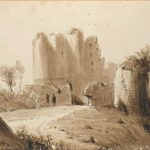
Historic
Franchimont castle (Liège province, municipality of Theux) used to be one of twelve residences and strongholds of the principality of Liège. It has been mentioned for the first time in written documents from 1155 but its first constructions probably date back to the time of bishops Henri de Verdun (1075 – 1091) and Otbert (1091 – 1119), fierce defenders of the principality during the feudal era.
Enclaved between the duchies of Limburg and Luxembourg and the principality of Stavelot, the principality of Franchimont therefore had its defensive system but also its administrative and judiciary center where the prince-bishop representative resided. The castle thus defended a sort of a frontier, a “step”.
To simplify, the current ruins can be divided in three concentric perimeters which roughly
correspond to the general evolution of fortifications from the Middle Age to the Modern Times.
The first perimeter is the castle strictly speaking, where are concentrated the vestiges of the medieval castle which has been transformed on various occasions, mostly throughout the 16th century.
Only little remains from the second perimeter which surrounded an expansion of the north and west fortification facing the access. One of the most remarkable remnants is the eastern reinforcement – also known as “the shield” (“le bouclier”, in French) – of the more than 20 meter high dungeon. It is a typical example of passive fortification of the late Middle Age (circa 1387) in order to counter the rise of the artillery.
The third perimeter, pentagonal this time, describes the shape of a bastion of which the tip is pointed due west. It dates back to Erald de la Marck time. With its blockhouses and canon tower at the entrance, it is a prime example of the military architecture developed by engineers during the early 16th century. It is comparable to constructions that can be found in Langres (France), in Mont-Saint-Michel (France) or in Soleure (Switzerland).
Despite the destruction that occurred during the French Revolution at the end of the 18th century, the ruins that remain are still impotent. Visiting them allow visitors to understand the evolution of military architecture and how it matched the armament, particularly the influence of black powder artillery.




